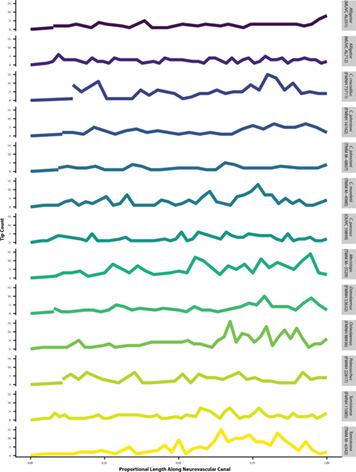当前位置:
X-MOL 学术
›
J. Morphol.
›
论文详情
Our official English website, www.x-mol.net, welcomes your
feedback! (Note: you will need to create a separate account there.)
Quantifying neurovascular canal branching patterns reveals a shared crocodylian arrangement
Journal of Morphology ( IF 1.5 ) Pub Date : 2020-11-02 , DOI: 10.1002/jmor.21295 Emily J Lessner 1
Journal of Morphology ( IF 1.5 ) Pub Date : 2020-11-02 , DOI: 10.1002/jmor.21295 Emily J Lessner 1
Affiliation

|
Highly branched dendritic structures are common in nature and often difficult to quantify and therefore compare. Cranial neurovascular canals, examples of such structures, are osteological correlates for somatosensory systems and have been explored only qualitatively. Adaptations of traditional stream‐ordering methods are applied to representative structures derived from computed tomography‐scan data. Applying these methods to crocodylian taxa, this clade demonstrates a shared branching pattern and exemplifies the comparative utility of these methods. Additionally, this pattern corresponds with current understanding of crocodylian sensory abilities and behaviors. The method is applicable to many taxa and anatomical structures and provides evidence for morphology‐based hypotheses of sensory and physiological evolution.
中文翻译:

量化神经血管管分支模式揭示了共享的鳄鱼排列
高度分支的树枝状结构在自然界中很常见,通常难以量化和比较。颅神经血管管,这种结构的例子,是躯体感觉系统的骨学相关性,并且只进行了定性研究。对传统流排序方法的改编适用于从计算机断层扫描数据导出的代表性结构。将这些方法应用于鳄鱼类群,这个进化枝展示了一个共享的分支模式,并举例说明了这些方法的比较效用。此外,这种模式符合目前对鳄鱼感官能力和行为的理解。该方法适用于许多分类群和解剖结构,并为基于形态学的感觉和生理进化假设提供证据。
更新日期:2020-11-02
中文翻译:

量化神经血管管分支模式揭示了共享的鳄鱼排列
高度分支的树枝状结构在自然界中很常见,通常难以量化和比较。颅神经血管管,这种结构的例子,是躯体感觉系统的骨学相关性,并且只进行了定性研究。对传统流排序方法的改编适用于从计算机断层扫描数据导出的代表性结构。将这些方法应用于鳄鱼类群,这个进化枝展示了一个共享的分支模式,并举例说明了这些方法的比较效用。此外,这种模式符合目前对鳄鱼感官能力和行为的理解。该方法适用于许多分类群和解剖结构,并为基于形态学的感觉和生理进化假设提供证据。











































 京公网安备 11010802027423号
京公网安备 11010802027423号